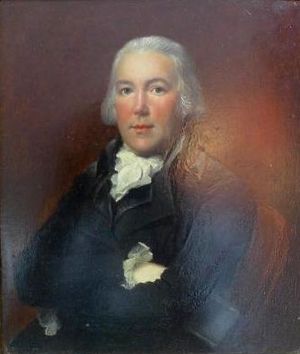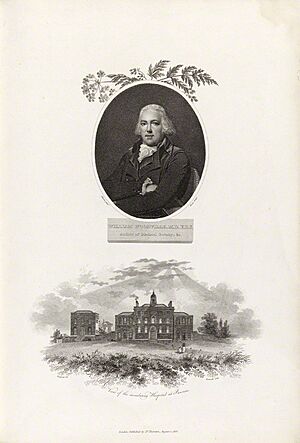William Woodville facts for kids

William Woodville (born in 1752, died in 1805) was an English doctor and a plant expert. He was one of the first people to support and use vaccination, a new way to prevent diseases. He was convinced by the important work of another doctor, Edward Jenner, who developed the smallpox vaccine. Woodville also wrote a very important book about plants used in medicine. This book had four parts and included 300 pictures of medicinal plants. It was a key guide for doctors for many years.
William Woodville's Life Story
William Woodville was born in 1752 in a town called Cockermouth in England. His family was wealthy. He first learned about medicines from an apothecary named William Birtwhistle. Later, he went to Edinburgh University to study medicine. He was a favorite student of a famous teacher named William Cullen. William Woodville earned his medical degree in 1775.
After traveling in Europe for a while, he started working as a doctor in England. In 1782, he moved to London. There, he became a doctor at the Middlesex dispensary. He also joined the College of Physicians in 1784.
Working with Smallpox
In 1791, William Woodville became a doctor at the smallpox and inoculation hospitals in London. He was very interested in Edward Jenner's new method of vaccination. This new method used material from cowpox to protect people from smallpox. Woodville was one of the first doctors to try this new way of preventing disease.
However, his results were different from Jenner's. There was some disagreement about how well the new method worked. People later thought that Woodville's vaccine might have been mixed with material from his smallpox patients. This could have changed how it worked.
His Love for Plants
William Woodville also loved botany, which is the study of plants. In 1791, he became a member of the Linnean Society, a group for naturalists. He even created a special garden for plants at the hospital. He paid for this garden himself. He used this garden to study plants and wrote his important book called Medical Botany. This book helped doctors learn about plants that could be used as medicine.
William Woodville lived in London. He died at the smallpox hospital on March 26, 1805. He was buried in a special burial ground. A portrait of him, painted by Lemuel Abbott, was given to the smallpox hospital.
What He Wrote
William Woodville wrote several important books and reports during his life:
- Medical Botany: This was his most famous work, published in parts between 1790 and 1794. It had many pictures and was updated several times.
- History of the Inoculation of the Smallpox in Great Britain: Published in 1796, this book looked at how smallpox prevention was done in Britain.
- Reports of a Series of Inoculations for the Variolæ Vaccinæ or Cow-pox: This report from 1799 shared his findings on using cowpox as a way to prevent smallpox.
- Observations on the Cow Pox: Another publication from 1800 where he shared his thoughts on cowpox.
- A Comparative Statement of Facts and Observations relative to the Cow-pox, published by Doctors Jenner and Woodville: In 1800, he published this to compare his findings with those of Edward Jenner.


